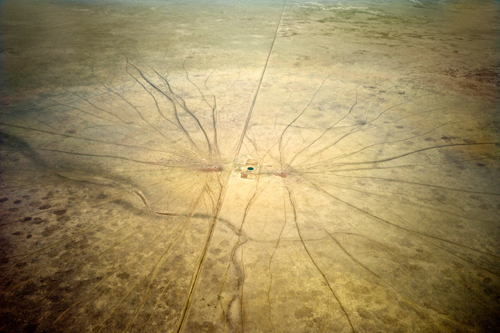Viviane DALLES
This post is also available in:
 Anglais
Anglais
L’expression latine Terra Nullius, désigne une Terre sans maître, une terre vide. Celle-ci peut cependant être habitée, mais ses habitants ne la cultivent pas. Le principe de Terra Nullius fut invoqué lors de la colonisation de l’Australie par les Britanniques, afin de légitimer l’invasion du continent, considérant les indigènes, comme étant une race inférieure vouée à devenir une infime partie de la population, voire à disparaître. Le 28 Avril 1770, l’explorateur britannique James Cook déclare le continent Terra Nullius. Cette déclaration va donner voie à la création d’une colonie pénitentiaire : entre 1788 et 1868, 165.000 condamnés britanniques sont envoyés par bateaux vers ce nouveau continent. Plus de deux siècles après, en 1992, suite à une bataille acharnée pour la reconnaissance des droits fonciers aborgènes, la Haute Cour d’Australie promulgue que le pays n’a jamais été Terra Nullius et invalide rétroactivement ce principe. En 2012, l’Australie, compte plus de 22 millions d’habitants. La forte majorité se trouve en bordure du continent dans des grandes villes telles que la capitale Canberra, ou Sydney, Melbourne entre autres. Cependant, près de dix pour cent occupe toujours le cœur du pays, le Bush et l’Outback, couvrant plus des deux tiers du territoire. Cet essai photographique a été réalisé pour l’essentiel dans l’état du Territoire du Nord, qui se situe dans la partie centrale et Nord du pays : ici, le temps et les distances s’étirent, l’horizon en devient obsessionnel. La population de l’Outback ne subit pas un tel environnement, elle épouse le rythme que cet isolement impose malgré l’impuissance que l’être humain peut parfois éprouver face aux forces de la nature. Les racines de ces habitants, plus ou moins récentes, sont bien implantées. D’autres sont venus d’une contrée lointaine voire d’outre mer, le desert leur a révélé plus que ce qu’ils n’ont jamais espéré. C’est alors un nouveau départ, au milieu de nulle part, il y a tout à faire. Le silence permet de mieux s’entendre. On est débarrassé de ses oripeaux. Gaye Nichols Immensité rugueuse et magnifique, violente et lumineuse, une hostilité qui se laisse apprivoiser si on veut bien en prendre le temps, un lien unique en somme, une histoire personnelle.
Viviane Dalles 2012
Terra Nullius, from the Latin, describes a land without an owner, an empty land. Whilst it may be inhabited, it is not actively farmed. During the colonisation of Australia by the British, the principle of Terra Nullius was evoked in a bid to legitimise the continent’s invasion. The indigenous population was considered to be an inferior race destined to become an insignificant part of the population, perhaps even to disappear over time. On 28th April 1770, the British explorer James Cook declared the continent Terra Nullius. This declaration paved the way for the creation of a new penal colony: between 1788 and 1868, 165.000 British convicts were sent to this new continent by boat. Over two centuries later, in 1992, the High Court of Australia declared the country never to have been Terra Nullius and retroactively invalidated this principle following a fierce battle for the recognition of Aboriginal land rights. In 2012, Australia has a population of over 22 million inhabitants. The big majority of Australia’s population lives on the continent’s periphery in large cities such as the capital Canberra, Sydney or Melbourne. Nevertheless, about ten percent of Australians call the centre of the country home, otherwise known as the Bush and the Outback, an area which covers over two thirds of the territory. The following photographic essay was largely undertaken in the state of Northern Territory, where time and distance seem endless, at 360 degrees, the horizon becomes an obsessional sight. The people of the desert adapt to the lifestyle that their isolation imposes, accepting their vulnerability to an often savage landscape. The roots of these people, some established here longer than others, run deep. Others have come from a faraway land, the Outback has given back more than they ever wished for. In the middle of nowhere it’s then a new beginning and all remains to be done. The silence allows us to better hear ourselves. We leave behind any artifice. Gaye Nichols Rugged and magnificent, violent and luminous, this savage landscape and the people who live within it; a story of personal adaptation.
Viviane Dalles 2012
NEWSLETTER
Pour recevoir nos informations, inscrivez votre adresse email.EN SAVOIR PLUS

Pour Que l’Esprit Vive,
Association loi 1901 reconnue d’utilité publique
Siège social
20 rue Lalande,
75014 Paris – France


